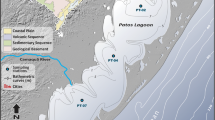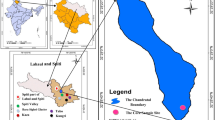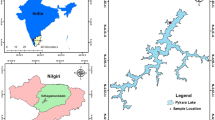Abstract
This study provides the sedimentation rates (SR) of three drainage basins at Itaipu Reservoir (Paraná State, Brazil) by applying 210Pb and 137Cs geochronological methods (CFCS and CRS models). The results based on the CRS model showed SR increasing in São Francisco Verdadeiro (SFV) and Ocoí (OCO) over the last decades (0.61 and 0.43 g cm2 yr−1, respectively). Arroio Fundo (ARF) showed the opposite trend with decreasing accumulation (0.19 g cm2 yr−1). The SR results indicate that precipitation changes in a period of rapid agricultural development influence each sub-basin differently depending on its drainage size area and watershed conditions.






Source of the data is from Instituto de Desenvolvimento Rural do Paraná (IAPAR, [97]). B Forest cover (%) of ARF, OCO, and SFV margins (10 km buffer). Data spanning 1989-to 2019 was obtained from MapBiomas [60]. Green shadow represents the last decade’s data, including mean percentage values of forest cover (%) for each site. Abreviations: Ocoí; ARF = Arroio Fundo; SFV = São Francisco Verdadeiro
Similar content being viewed by others
References
Wang Z, Hu C (2009) Strategies for managing reservoir sedimentation. Int J Sediment Res 24:369–384. https://doi.org/10.1016/S1001-6279(10)60011-X
Pereira ECB, Lopes FB, de Almeida AMM et al (2021) Sediments and nutrients input to a small reservoir in the tropical semi-arid region1. Rev Ciência Agronômica 52(1):e20196717
Isidorova A (2020) The origin and fate of sediment organic carbon in tropical reservoirs Doctoral Dissertation, Acta Universitatis Upsaliensis, 47p, ISBN 978–513–0938–5
Castro PW, Mantilla CA (2021) Implementation of strategies for the management of dams with sedimented reservoirs Water Resour Manag 1–15 In: Water Resources Management: An International Journal, Published for the European Water Resources Association (EWRA), Springer; European Water Resources Association (EWRA) 35(13): 4399–4413
Cimorelli L, Covelli C, De Vincenzo A et al (2021) Sedimentation in reservoirs: evaluation of return periods related to operational failures of water supply reservoirs with Monte Carlo simulation. J Water Resour Plan Manag 147:4020096
Anjun D, Jianguo C, Haihua HU, Hongling SHI (2020) A review of reservoir sedimentation control and storage capacity recovery. Meteorol Environ Res 11:10–15
Fripp J, Morris G, Hajimirzaie S, Hoeft CC (2020) Sedimentation and Small Dams In: World environmental and water resources congress 2020: Hydraulics, waterways, and water distribution systems analysis American Society of Civil Engineers Reston, VA, pp 195–201
Hauer C, Wagner B, Aigner J et al (2018) State of the art, shortcomings and future challenges for sustainable sediment management in hydropower: a review. Renew Sustain Energy Rev 98:40–55
de Faria RT, Junior RC, Werner SS et al (2016) Soybean yield in relation to distance from the Itaipu reservoir. Int J Biometeorol 60:1015–1028. https://doi.org/10.1007/s00484-015-1093-8
Volsi B, De Castro GHL, Da Costa GVAZ, et al. (2020) Spatial Distribution, evolution and structure of maize and soybean production systems in the state of Paraná Brazilian J Maize Sorghum https://doi.org/10.18512/rbms2020v19e1122
Wagner-Riddle C, Werner SS, Caramori P et al (2015) Determining the influence of Itaipu Lake on thermal conditions for soybean development in adjacent lands. Int J Biometeorol 59:1499–1509. https://doi.org/10.1007/s00484-015-0960-7
Agostinho AA, Thomaz SM, Gomes LC (2018) Threats for biodiversity in the floodplain of the Upper Paraná River: effects of hydrological regulation by dams. Ecohidrology and Hydrobiology 4, 3:255–256
Norton LD, Castro Filho C, Cochrane TA, et al (2001) Monitoring the sediment loading of Itaipu Lake and modeling of sheet and rill erosion hazards in the watershed of the Parana River: an outline of the Project. In: Sustaining the Global Farm Selected Papers from the 10th International Soil Conservation Org Meet, pp 321–323
Begy R, Cosma C, Timar A (2009) Recent changes in Red Lake (Romania) sedimentation rate determined from depth profiles of 210Pb and 137Cs radioisotopes. J Environ Radioact 100:644–648
Díaz-Asencio M, Corcho-Alvarado JA, Cartas-Aguila H et al (2017) 210Pb and 137Cs as tracers of recent sedimentary processes in two water reservoirs in Cuba. J Environ Radioact 177:290–304. https://doi.org/10.1016/j.jenvrad.2017.07.005
Simms AD, Woodroffe C, Jones BG et al (2008) Use of 210Pb and 137Cs to simultaneously constrain ages and sources of post-dam sediments in the Cordeaux reservoir, Sydney, Australia. J Environ Radioact 99:1111–1120. https://doi.org/10.1016/j.jenvrad.2008.01.002
Ivanoff MD, Toldo EE, Figueira RCL, de Lima Ferreira PA (2020) Use of 210 Pb and 137 Cs in the assessment of recent sedimentation in Patos Lagoon, southern Brazil Geo-Marine Letter 40: 1057–1067
Oldfield F, Appleby PG (1984) Empirical testing of 210 Pb-dating models for lake sediments In: Lake sediments and environmental history, Leicester University Press, 93–124
Appleby PG (2008) Three decades of dating recent sediments by fallout radionuclides: a review. The Holocene 18:83–93. https://doi.org/10.1177/0959683607085598
Appleby PG, Oldfield F (1978) The calculation of 210Pb dates assuming a constant rate of supply of unsupported 210Pb to the sediment. CATENA 5:1–8
Liu S, Narentuya XB et al (2012) Using 210Pb and 137Cs to date recent sediment cores from the Badain Jaran Desert, Inner Mongolia, China. Quat Geochronol 12:30–39. https://doi.org/10.1016/j.quageo.2012.06.001
Singh KK, Vasudevan S (2021) Reconstruction of sedimentation rates based on the chronological framework of Lake Pykara, Tamil Nadu, India. Environ Monit Assess 193:1–12
Sanchez-Cabeza JA, Masque P, Ani Ragolta I, et al. (2020) Estimation of sedimentation rates in the meromictic lake Svetloe (Northern Arkhangelsk region) using 210Pb dating. In: Water Resources: Research and Management (School and Workshop). Proceedings of the 6th p 143
Angeli JLF, Venturini N, de Lima Ferreira PA, Figueira RCL (2016) Recent sedimentation rates in the Caravelas estuary (Bahia, Brazil) using unsupported 210Pb and 137Cs modeling. Radiochim Acta 104:513–522
Passaia OA, Siqueira VA, Brêda JPLF et al (2020) Impact of large reservoirs on simulated discharges of Brazilian rivers. Braz J Water Resour 25:17. https://doi.org/10.1590/2318-0331.252020190084
Bini LM, Thomaz SM, Carvalho P (2010) Limnological effects of Egeria najas Planchon (Hydrocharitaceae) in the arms of Itaipu Reservoir (Brazil, Paraguay). Limnology 11:39–47. https://doi.org/10.1007/s10201-009-0286-4
Anual RIO, Binacional I (2019) Relatório Anual Itaipu Binacional. https://www.itaipu.gov.br/institucional/relatorio-anual Consulted in January of 2022
Junior ILC, Lopes TR, Fonseca BAB et al (2018) Evaluation of pseudo-total and labile metals (Cu2+, Cr3+, Ni2+, Mn2+, Pb2+ and Zn2+) in surface sediments at the mouth of tributaries of the Itaipu Reservoir, Brazil. Eclética Química 43:51–61
Costa Junior IL, Machado CS, Pletsch AL, Torres YR (2020) Simultaneous HPLC-PDA determination of commonly prescribed antidepressants and caffeine in sludge from sewage treatment plants and river sediments in the Itaipu reservoir region, Paraná, Brazil. Int J Environ Anal Chem 100:1004–1020
Quinonez Fernandez OV, Bertalan L (2018) Magnitude of shoreline retreat in the Itaipu Reservoir (Brazil-Paraguay border region) from 1984 to 2016 In: EGU General Assembly Conference Abstracts p 1560
Anderson W (2018) Restoring the watershed of one of the world's largest dams could save millions In: Initiative 20x20 Program https;//initiative20x20/restoring-latin-america-landscapes Accessed 03 Jan 2022
Leli IT, Stevaux JC, Assine ML (2020) Origin, evolution, and sedimentary records of islands in large anabranching tropical rivers: the case of the Upper Paraná River. Brazil Geomorphology 358:107118
Leli IT, Hayakawa EH, dos Santos VC, Stevaux JC (2021) Island and anabranching generation processes-a comparative review in the Upper Paraná River Rev Bras Geomorfol https://doi.org/10.20502/rbg.v22il.1830
Meurer T, Mormul RP, Bueno NC (2020) Environmental predictors of charophytes in a subtropical reservoir. Acta Limnol Bras 32:e9. https://doi.org/10.1590/S2179-975X1118
Thomaz SM, Bini LM, de Souza MC et al (1999) Aquatic macrophytes of Itaipu Reservoir, Brazil: survey of species and ecological considerations. Brazilian Arch Biol Technol 42:1. https://doi.org/10.1590/S1516-89131999000100003
Pagioro TA, Thomaz SM (2002) Longitudinal patterns of sedimentation in a deep, monomictic subtropical reservoir (Itaipu, Brazil-Paraguay). Arch fur Hydrobiol 154:515–528. https://doi.org/10.1127/archiv-hydrobiol/154/2002/515
Da Silva GS, Miola S, Da Silva GS, De Sousa ER (2010) Evaluation of the water quality of Rio São Francisco Falso, tributary of Itaipu Reservoir, parana | Avaliação da qualidade das águas do Rio São Francisco Falso, tributário do Reservatório de Itaipu, paraná. Eclet Quim 35:117–122. https://doi.org/10.1590/s0100-46702010000300011
Ribeiro Filho RA, Petrere Junior M, Benassi SF, Pereira JMA (2011) Itaipu Reservoir limnology: eutrophication degree and the horizontal distribution of its limnological variables. Brazilian J Biol 71:889–902
Ribeiro Filho RA, Myriam J, de Almeida P, Miguel Petrere J, Simone Frederigi B (2013) Eutrophication indexes used as fish production parameters in the Itaipu Reservoir (Brazil). J Environ Prot (Irvine, Calif) 4:151–178. https://doi.org/10.4236/jep.2013.47A018
Ribeiro Filho RA, Junior MP, Agostinho ÂA et al (2015) Historical evolution of the trophic and limnological relationships in the Itaipu reservoir: top-down and bottom-up effects upon fish production. Adv Biosci Biotechnol 6:390
de Souza CF, Pereira JMA, Benassi SF, Filho RAR (2019) Trophic state index (TSI) of the Reservoir of the Itaipu Binacional hydroelectric power plant. Brazil Mod Environ Sci Eng 5(7):615–624
Ouchi-Melo LS, do Amaral B, Tavares DA, et al (2021) Brazilian vs Paraguayan streams: Differences in water quality in a cross-border subtropical region Limnologica 90, ISSN 0075–9511 https://doi.org/10.1016j.limno.2021.125904
Ward JV, Tockner K, Arscott DB, Claret C (2002) Riverine landscape diversity. Freshw Biol 47:517–539
Walling DE (2011) Human impact on the sediment loads of Asian rivers. Sediment Probl Sediment Manag Asian River Basins, IAHS Publ 349:37–51
Rudke AP, Fujita T, de Almeida DS et al (2019) Land cover data of upper Parana River Basin, South America, at high spatial resolution. Int J Appl Earth Obs Geoinf. https://doi.org/10.1016/j.jag.2019.101926
Stivari SMS, De Oliveira AP, Soares J (2005) On the climate impact of the local circulation in the Itaipu Lake area. Clim Change 72:103–121. https://doi.org/10.1007/s10584-005-5923-2
Aparecido LE de O, Rolim G de S, Richetti J, et al (2016) Köppen, Thornthwaite and Camargo climate classifications for climatic zoning in the State of Paraná, Brazil. Ciência e Agrotecnologia 40:405–417
Silva WL, Xavier LNR, Maceira MEP, Rotunno OC (2019) Climatological and hydrological patterns and verified trends in precipitation and streamflow in the basins of Brazilian hydroelectric plants. Theor Appl Climatol 137:353–371
Camilloni IA, Barros VR (2003) Extreme discharge events in the Paraná River and their climate forcing. J Hydrol 278:94–106
Cunha DGF, Benassi SF, de Falco PB, do Carmo Calijuri M (2016) Trophic state evolution and nutrient trapping capacity in a transboundary subtropical reservoir: a 25-Year Study. Environ Manag 57:649–659 https://doi.org/10.1007/s00267-015-0633-7
IBGE C (2000) Instituto Brasileiro de Geografia e Estatística-IBGE. https;//www.ibge.gov.br. Accessed 02 Jan 2022
Jweda J, Baskaran M (2011) Interconnected riverine-lacustrine systems as sedimentary repositories: case study in southeast Miching using 210Pb and 137Cs-based sediment accumulation and mixing models. J Great Lakes Res 37:432–446
de Lima Ferreira PA, Figueira RCL, Siegle E et al (2016) Using a cesium-137 (137Cs) sedimentary fallout record in the South Atlantic Ocean as a supporting tool for defining the Anthropocene. Anthropocene 14:34–45
Ferreira PA de L (2014) Aplicação do modelo de migração vertical de 137Cs para o cálculo de taxas de sedimentação recente em ambientes costeiros. Dissertation, University of São Paulo, Oceanographic Institute, Brazil https://doi.org/10.11606/D.21.2014.tde-09042015-140821
Barsanti M, Garcia-Tenorio R, Schirone A et al (2020) Challenges and limitations of the 210Pb sediment dating method: results from an IAEA modelling interlaboratory comparison exercise. Quat Geochronol 59:101093
Robbins JA, Edgington DN (1975) Determination of recent sedimentation rates in Lake Michigan using Pb-210 and Cs-137. Geochim Cosmochim Acta 39:285–304
Sanchez-Cabeza JA, Ruiz-Fernández AC (2012) 210Pb sediment radiochronology: an integrated formulation and classification of dating models. Geochim Cosmochim Acta 82:183–200
Mabit L, Benmansour M, Abril JM et al (2014) Fallout 210Pb as a soil and sediment tracer in catchment sediment budget investigations: a review. Earth-Science Rev 138:335–351
ESRI (2011) ArcGIS Desktop: Release 10. Redlands, CA, Environmental Systems Research Institute
MapBiomas (2021) Brasil. http://mapbiomas.org. Accessed 12 Dec 2021
Google Earth Engine (2021) https://earthengine.google.com. Accessed 12 Dec 2021
Landsberger S, Biegalski S, Kapsimalis R (2013) The correct and incorrect way to calibrate a compton suppression counting system for gamma-ray efficiency. J Radioanal Nucl Chem 296:309–313
Swarzenski PW (2014) 210Pb dating. Encycl sci dating methods; Rink, WJ, Thompson, JW, Eds 626–631
Ligero RA, Ramos-Lerate I, Barrera M, Casas-Ruiz M (2001) Relationships between sea-bed radionuclide activities and some sedimentological variables. J Environ Radioact 57:7–19
Saengkul C, Pakkong P, Sawangwong P (2013) Effect of sediment characteristics on sorption of 137Cs at the sediment-water interface. IOSR J Environ Sci Tox Food Tech 4:122–125
Misumi K, Tsumune D, Tsubono T et al (2014) Factors controlling the spatiotemporal variation of 137Cs in seabed sediment off the Fukushima coast: implications from numerical simulations. J Environ Radioact 136:218–228
Brenner M, Schelske CL, Kenney WF (2004) Inputs of dissolved and particulate 226Ra to lakes and implications for 210Pb dating recent sediments. J Paleolimnol 32:53–66
Brenner M, Smoak JM, Leeper DA et al (2007) Radium-226 accumulation in Florida freshwater mussels. Limnol Oceanogr 52:1614–1623
Mohamed CAR, Mahmood ZUW, Ahmad Z, Ishak AK (2010) Enrichment of natural radium isotopes in the southern South China Sea surface sediments. Coast Mar Sci 34:165–171
Wan Mahmood Z, Mohamed C, Yii M et al (2010) Vertical inventories and fluxes of 210Pb, 228Ra and 226Ra at the southern South China Sea and Malacca Straits. J Radioanal Nucl Chem 286:107–113
Santos EB, de Freitas ED, Rafee SAA et al (2021) Spatio-temporal variability of wet and drought events in the Paraná River basin—Brazil and its association with the El Niño—Southern oscillation phenomenon. Int J Climatol 41(10):4879–4897
Camilloni I, Barros V (2000) The Parana river response to El Nino 1982–83 and 1997–98 events. J Hydrometeorol 1:412–430
FAO (2022) Food and Agriculture Organization of the United Nations. https://www.fao.org/faostat/en/#data. Accessed 07 Feb 2022
Embrapa, Empresa Brasileira de Pesquisa Agropecuária, Ministério da Agricultura Pecuária e Abastecimento. https://www.agencia.cnptia.embrapa.br/gestor/soja/arvore/CONTAG01_10_271020069131.html. Accessed 07 Fev 2022
Lorenzon AS, Ribeiro CAAS, Dos Santos AR et al (2017) Itaipu royalties: the role of the hydroelectric sector in water resource management. J Environ Manag 187:482–489
Dalló SC, Zdziarski AD, Woyann LG et al (2020) Key locations for soybean genotype assessment in South Brazil region. Semin Ciências Agrárias 41:767–782
da Silva AP, Barbosa MAGA, Costa CW, Mauad FF (2021) Environmental fragility analysis in reservoir drainage basin land use planning: a Brazilian basin case study. Land Use Policy 100:104946. https://doi.org/10.1016/j.landusepol.2020.104946
Yang X, Lu XX (2013) Ten years of the Three Gorges Dam: a call for policy overhaul. Environ Res Lett. https://doi.org/10.1088/1748-9326/8/4/041006
Wu J, Huang J, Han X et al (2004) The three gorges dam: an ecological perspective. Front Ecol Environ 2:241–248
Xu K, Milliman JD (2009) Seasonal variations of sediment discharge from the Yangtze River before and after impoundment of the Three Gorges Dam. Geomorphology 104:276–283
Tang X, Li R, Wu M et al (2019) Influence of turbid flood water release on sediment deposition and phosphorus distribution in the bed sediment of the Three Gorges Reservoir, China. Sci Total Environ 657:36–45
Zheng S, Xu YJ, Cheng H et al (2018) Riverbed erosion of the final 565 kilometers of the Yangtze River (Changjiang) following construction of the Three Gorges Dam. Sci Rep 8:1–11
Lu XX, Higgitt DL (2000) Estimating erosion rates on sloping agricultural land in the Yangtze Three Gorges, China, from caesium-137 measurements. CATENA 39:33–51
Fontana L, Albuquerque ALS, Brenner M et al (2014) The eutrophication history of a tropical water supply reservoir in Brazil. J Paleolimnol 51:29–43
Mendonça R, Kosten S, Sobek S et al (2016) Organic carbon burial efficiency in a subtropical hydroelectric reservoir. Biogeosciences 13:3331–3342
Fávaro D, Damatto S, Moreira E et al (2007) Chemical characterization and recent sedimentation rates in sediment cores from Rio Grande reservoir, SP, Brazil. J Radioanal Nucl Chem 273:451–463
da Conceição FT, Fernandes AM, Hissler C et al (2020) Multi-tracer analysis to estimate the historical evolution of pollution in riverbed sediment of a subtropical watershed, the lower course of the Piracicaba River, São Paulo. Brazil Sci Total Environ 743:140730
Cardoso-Silva S, Mizael J, Frascareli D et al (2021) Paleolimnological evidence of environmental changes in seven subtropical reservoirs based on metals, nutrients, and sedimentation rates. CATENA 206:105432. https://doi.org/10.1016/j.catena.2021.105432
Cardoso-Silva S, de Lima Ferreira PA, Moschini-Carlos V et al (2016) Temporal and spatial accumulation of heavy metals in the sediments at Paiva Castro Reservoir (São Paulo, Brazil). Environ Earth Sci 75:1–16. https://doi.org/10.1007/s12665-015-4828-2
de Souza VLB, Rodrigues KRG, Pedroza EH et al (2012) Sedimentation rate and 210Pb sediment dating at Apipucos Reservoir, Recife, Brazil. Sustainability 4:2419–2429. https://doi.org/10.3390/su4102419
Moungsrijun S, Srisuksawad K, Lorsirirat K, Nantawisarakul T (2010) Using fallout 210Pb measurements to estimate sedimentation rate in Lam Phra Phloeng dam Thailand Curr Sci 542–547
Méndez-García C, Renteria-Villalobos M, García-Tenorio R, Montero-Cabrera ME (2014) Uranium series isotopes concentration in sediments at San Marcos and Luis L. Leon reservoirs, Chihuahua, Mexico 83:83–92. https://doi.org/10.1063/1.4890707
Nehyba S, Nývlt D, Schkade U et al (2011) Depositional rates and dating techniques of modern deposits in the Brno reservoir (Czech Republic) during the last 70 years. J Paleolimnol 45:41–55. https://doi.org/10.1007/s10933-010-9478-5
Ju L, Wen A, Long Y et al (2013) Using 137 Cs tracing methods to estimate soil redistribution rates and to construct a sediment budget for a small agricultural catchment in the three gorges reservoir region, China. J Mt Sci 10:428–436
Anjum R, Gao J, Tang Q et al (2017) Linking sedimentary total organic carbon to 210Pbex chronology from Changshou lake in the three gorges reservoir Region, China. Chemosphere 174:243–252
Chen X, Qiao Q, McGowan S et al (2019) Determination of geochronology and sedimentation rates of shallow lakes in the middle Yangtze reaches using 210Pb, 137Cs spheroidal carbonaceous particles. CATENA 174:546–556
IAPAR (2021) Instituto de Desenvolvimento Rural do Paraná. https://www.idrparana.pr.gov.br. Accessed 12 Dec 2021
IBGE (2022) Instituto Brasileiro de Geografia e Estatística. https://www.ibge.gov.br. Accessed 10 Jan 2022
Acknowledgements
The authors would like to thank the Technological Itaipu Park and Itaipu Binational for the sponsoring and technical support to the first author (Grants 902859/2021 and 902377/2019). Also, for the valuable help and scientific discussions promoted by the researchers of the “Núcleo de Inteligência Territorial/ NIT-Eixo Água.” Finally, we are immensely thankful for the two anonymous reviewers and the journal editor's helpful suggestions that improved the manuscript.
Author information
Authors and Affiliations
Corresponding author
Ethics declarations
Conflict of interest
The authors declare that they have not known competing financial interests or personal relationships that could have influenced the work reported in this paper.
Additional information
Publisher's Note
Springer Nature remains neutral with regard to jurisdictional claims in published maps and institutional affiliations.
Supplementary Information
Below is the link to the electronic supplementary material.
Rights and permissions
About this article
Cite this article
Fontana, L., Ferreira, P.A., Benassi, R.F. et al. Sedimentation rate inferred from 210Pb and 137Cs dating of three sediment cores at Itaipu reservoir (Paraná State, Brazil) the world’s second largest hydroelectricity producer. J Radioanal Nucl Chem 331, 3571–3589 (2022). https://doi.org/10.1007/s10967-022-08380-4
Received:
Accepted:
Published:
Issue Date:
DOI: https://doi.org/10.1007/s10967-022-08380-4




